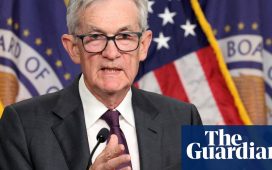Strong US growth looks set to boost Federal Reserve officials’ belief that they can afford to take their time on cutting rates, as they prepare to meet on Wednesday.
The Federal Open Market Committee will almost certainly vote to leave benchmark interest rates unchanged at a 23-year high of 5.25-5.5 per cent, after a lengthy effort to tame rampant inflation.
However, a question remains over the extent to which Fed chair Jay Powell will hint at cuts on the horizon. About half of investors are currently pricing in a move at the following Fed meeting in March, but many economists point instead to late spring or early summer.
The concern for rate-setters is that a premature cut could result in price pressures bouncing back. Those betting on a later move say the US economy is healthy enough to for the Fed to mitigate this risk by holding rates higher for longer.
Gross domestic product grew at an annualised rate of 3.3 per cent in the fourth quarter, marking a strong finish to a year in which many economists thought the US would fall into recession.
Growth for the year as a whole was 3.1 per cent — the best performance of any major advanced economy.
“There’s just nothing in the data since the start of the year to signal the economy is in danger,” said Krishna Guha, a former Fed official who is now at Evercore ISI.
“If you’re a policymaker, you have a tonne of choice on when to go. And starting later plays to this desire to confirm that everything is on track to durably return inflation to 2 per cent,” he said.
Last month, Fed governor Christopher Waller said he was confident the central bank was within “striking distance” of hitting its 2 per cent inflation target, after a sharp fall in price pressures in the second half of 2023.
However, he argued that strong growth and a tight labour market meant officials did not have to act too hastily. “I see no reason to move as quickly or cut as rapidly as in the past,” Waller said.
Seth Carpenter, an economist at Morgan Stanley who believes the first cut will come in June, said divergent bets on the timing of cuts reflected widely differing views of the outlook for the US economy.
“Some people do still think that there will be a recession in 2024,” Carpenter said. “Others think that inflation is now entirely under control.”
“We expect a soft landing, but we’re not in an entirely different place to markets,” he added. “If we’re wrong on June, I expect it will be because cuts are going to be earlier, not later, than our baseline.”
Fed-watchers think that, barring an economic disaster, rate-setters will want to signal a meeting in advance that cuts are on the way.
“I would expect that, if they’re planning on March, then we would get a pretty clear hint of that from Powell in January,” said Guha, who forecasts May or June as the most likely timing for the first cut.
However, some say it would be difficult for Powell to give a strong indication of such a move this week, given that headline US inflation rose from 3.1 per cent in November to 3.4 per cent last month.
But the measure the Fed is watching most closely, core PCE inflation, fell to an annual rate of 2.9 per cent in December.
The Fed chair could also be reluctant to definitively rule out a cut on March 20, since two more sets of non-farm payrolls data, the key indicator of the health of the US jobs market, are due to be published in the interim.
A PCE inflation report for January and two sets of headline inflation figures are also expected before the March meeting, as well as data revisions revealing the degree to which seasonal adjustments affected December’s rise.
“The flow of data is going to be super important,” Carpenter said.
Another issue on the table at the Fed meeting is whether to slow quantitative tightening. The US central bank currently runs off up to $60bn in US Treasuries and $35bn in other government securities each month.
However, the minutes from the December meeting noted that some members felt that the pace of QT soon needed to be reviewed.
A sharp drop in money market funds’ use of a facility to buy and sell Treasuries from the central bank could mark the beginning of the end of a period of abundant liquidity, they said.
Since then Lorie Logan, president of the Dallas Fed and former head of the New York Fed’s markets team, has noted that slowing the pace of QT could lessen the chances of spikes in funding costs.
Avoiding those jumps would enable the Fed to carry on shrinking its balance sheet uninterrupted for longer, she said.
Nate Wuerffel, a former head of domestic markets at the New York Fed and now at BNY Mellon, said sharp upticks in funding costs during earlier episodes of QT in 2019 would push officials to make a decision sooner rather than later.
“There’s this notion of slowing and then stopping [the run-off of assets] well in advance of reserves falling from abundant to ample levels,” Wuerffel said.
“Policymakers are talking about this because some of them have really deep memories of the 2019 experience and they want to give the banking system time to adjust to lower levels of reserves.
“They know there are limits to what the data can tell us about how money markets are going to behave.”








